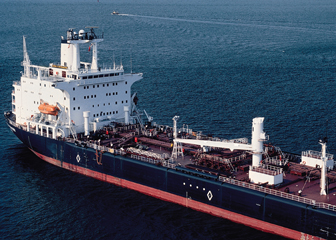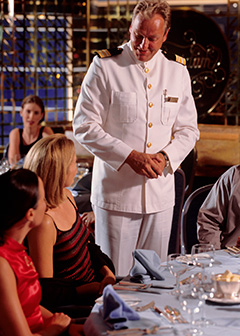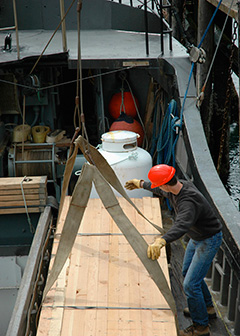What Water Transportation Occupations Do
About this section

Captains and mates supervise other workers.
Workers in water transportation occupations operate and maintain ships that take cargo and people over water. These ships travel to and from foreign ports across the ocean, to domestic ports along the coasts, across the Great Lakes, and along the country’s many inland waterways.
Duties
Water transportation workers typically do the following:
- Operate and maintain private ships
- Follow their ship’s strict chain of command
- Ensure the safety of all people and cargo on board
These workers, sometimes called merchant mariners, work on a variety of ships.
Some operate large deep-sea container ships to transport manufactured goods around the world.
Others work on bulk carriers that move heavy commodities, such as coal or steel across the oceans and over the Great Lakes.
Still others work on both large and small tankers that carry oil and other liquid products around the country and the world. Others work on supply ships that transport equipment and supplies to offshore oil and gas platforms.
Workers on tugboats help barges and other boats maneuver in small harbors and at sea.
Salvage vessels that offer emergency services also employ merchant mariners.
Cruise ships employ a large number of water transportation workers, and some merchant mariners work on ferries to transport passengers along shorter distances.
A typical deep sea merchant ship, large coastal ship, or Great Lakes merchant ship employs a captain and chief engineer, along with three mates, three assistant engineers, and a number of sailors and marine oilers. Smaller vessels that operate in harbors or rivers may have a smaller crew, with a captain, sometimes a mate, and one to a few sailors.
Also, there are other workers on ships, such as cooks, electricians, and mechanics, who do not need a merchant marine license. For more information, see the profiles on cooks, electricians, and general maintenance and repair workers.
The following are some types of water transportation occupations:
Captains, sometimes called masters, have overall command of a ship. They have the final responsibility for the safety of the crew, cargo, and passengers. Captains typically do the following:
- Supervise the work of other officers and the crew
- Ensure that proper safety procedures are followed
- Assess their crew’s abilities and determine if more workers are needed
- Prepare a maintenance and repair budget
- Oversee the loading and unloading of cargo or passengers
- Keep logs and other records that track the ship's movements and activities
- Interact with passengers on cruise ships
Mates, or deck officers, direct the operation of a ship while the captain is off duty. Large ships have three officers, called first, second, and third mates. The first mate has the highest authority and takes command of the ship if the captain is incapacitated. Usually, the first mate is in charge of the cargo and/or passengers, the second mate is in charge of navigation, and the third mate is in charge of safety. On smaller vessels, there may be only one mate. Deck officers typically do the following:
- Alternate watches with the captain and other officers
- Supervise and coordinate the activities of the deck crew
- Directly oversee docking the ship
- Monitor the ship’s position, using charts and other navigational aides
- Determine the speed and direction of the vessel
- Inspect the cargo hold during loading, to ensure that the cargo is stowed according to specifications
- Make announcements to passengers, when needed
Pilots guide ships in harbors, on rivers, and on other confined waterways. They work in places where a high degree of familiarity with local tides, currents, and hazards is needed. Many pilots are independent contractors and go aboard a ship to guide it through a particular waterway. Some, called harbor pilots, work for ports and help many ships coming into the harbor during the day.
Sailors, or deckhands, operate and maintain the vessel and deck equipment. They make up the deck crew and keep all parts of a ship, other than areas related to the engine and motor, in good working order. New deckhands are called ordinary seamen and do the least-complicated tasks. Experienced deckhands are called able seamen and usually make up most of a crew. Some large ships have a boatswain, who is the chief of the deck crew. Sailors typically do the following:
- Stand watch, looking for other vessels or obstructions in their ship’s path, as well as looking for navigational aids, such as buoys and lighthouses
- Steer the ship and measure water depth in shallow water
- Do routine maintenance, such as painting the deck and chipping away rust
- Keep the inside of the ship clean
- Handle lines when docking or departing
- Tie barges together when they are being towed
- Load and unload cargo
- Help passengers, when needed
Ship engineers operate and maintain a vessel’s propulsion system. This includes the engine, boilers, generators, pumps and other machinery. Large vessels usually carry a chief engineer, who has command of the engine room and its crew, and a first, second, and third assistant engineer. The engineer’s alternate oversees the engine and related machinery. Engineers typically do the following:
- Maintain the electrical, refrigeration, and ventilation systems of a ship
- Start the engine and regulate the vessel’s speed, based on the captain’s orders
- Record information in an engineering log
- Keep an inventory of mechanical parts and supplies
- Do routine maintenance checks throughout the day
- Calculate refueling requirements
Marine oilers work in the engine room, helping the engineers keep the propulsion system in working order. They are the engine room equivalent of sailors. New oilers are usually called wipers or pumpmen on vessels handling liquid cargo. With experience, an oiler can become a Qualified Member of the Engine Department (QMED). Marine oilers typically do the following:
- Lubricate gears, shafts, bearings, and other parts of the engine or motor
- Read pressure and temperature gauges and record data
- Help engineers with repairs to machinery
- Connect hoses, operate pumps, and clean tanks
Motorboat operators run small, motor-driven boats that carry six or fewer passengers. They work for a variety of services, such as fishing charters, tours, and harbor patrols.













